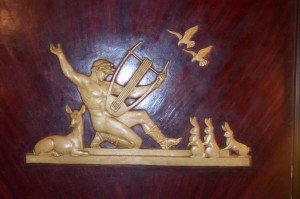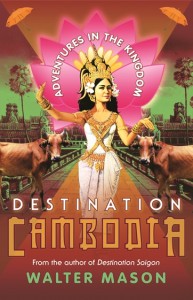Is a favourite saying of a friend of mine. But on a nose-freezing day in the mountains, with stark trees clawing at heavy skies, and a bone-chilling wind or drizzle, I find there’s nothing better than to seek reassurance in things that not only provide comfort, but remind us of comforts past.
Nostalgia is to do with the senses, with taste, feel, touch and smell. It’s about atmosphere. Nostalgia is a yearning for times past, characterised by objects, by significant things.
Watching an old black and white movie I’m reminded of childhood. A blazing hot Saturday in Queensland, lolling on the lounge, drinking glasses of cold milk with bobbing fragments of Milo on top, and watching Hollywood films, old even then: The Ghost and Mrs Muir, Rebecca, All about Eve. Those films incongruous with my life experience, country and place, nevertheless are a thread to the past, to where I lived in the past and are nostalgic, comforting. Those films form a part of my personal canon, a creative wellspring, just like books I’ve re-read and loved. There’s an over-enjoyment in knowing the lines, what comes next.
Why isn’t nostalgia what it used to be? Nostalgia has become marketable. Clothes are sold with rents and rip marks to emulate old, well-loved garments. You can buy a new windcheater with that ‘stretched’ look. Country-style furniture is patterned with fake borer holes. Replica 70s stuff is everywhere, from Planet lamps to toys, to signs.
This duplication of the old and well-loved tells us that nostalgia is not dead. Nostalgia is ‘cool’.
I looked up the origins of the word. A Swiss doctor, Johannes Hofer invented the term at the end of the 17th century, in reference to Swiss mercenary soldiers, as a replacement for the term, ‘homesickness’. It described a medical syndrome characterised by persistent memories of home, and the yearning to return, and included physical and psychological symptoms such as melancholy, sleeplessness, anxiety.
Is nostalgia dangerous?
According to academic Avishai Margalit (2011), nostalgia may seem harmless, and often is, but in its idealisation and distortion of the past, its shrouding of the object in purity and innocence, it can forget the bad, or evil. Nostalgia is the cousin of sentimentality. It can become “the fuel of kitsch”(p. 274). As an example, he points to contemporary German Ostalgia, the nostalgia for life in former East Germany, which sentimentalises the Skoda and ignores the Stazi. Threats to such innocence and purity, anything different, can be perceived as demonic.
Patrick White explored these kinds of ideas:
Mrs Jolley listened, hoping she might hear a body fall. She hoped Miss Hare might die, even. Then all that was bright and solid, all that was known and vouched for must prevail.
So Mrs Jolley rushed at the oven, to bake a cake, although it was not a day of celebration, but she liked to bake, a pink cake for choice, with non-parelles, and something written on it. With the Mothers’ Union and the Ladies’ Guild, with the Fellowships, Senior and Junior, pink was always popular, and what is popular is safe. (p.59)
Mrs Jolley’s pink cake is symbolic of all that is good, true, sure and safe. The atmosphere evoked by the baking cake brought with it thoughts of “little girls with fresh frocks” and “lovely little boys”. But Miss Hare begins to fear the housekeeper following the presentation of the cake, becomes haunted by it, and recognises the presence of evil in the virtues Mrs Jolley has brought to her life.
Nostalgia can distort the past and create an illusion of the loss of innocence, which can then invite brutality. But nostalgia’s longing can also create a sense of continuity and home. Over the centuries, migrants and refugees have described symptoms ranging from loneliness and listlessness to severe psychosomatic illnesses as well as hallucinations and delusions.
Psychologist Alexander Zinchenko (2012) writes about the loss of home triggering such symptoms, and equating with a loss of sense of self, of orientation in time and history. The loss of place and home can be the loss of your personal world, your self. One of Zinchenko’s study participants told him that, “People do not know what awaits them.” He says that this is not just about the unfamiliar language or the strange climate, but the absence of home, because “…home remembers us and defines our sense of self-constancy”(Zinchenko, 2012. p. 74).
Nostalgia then, can provide a resting place, a connection to the past and to the future. Objects, and photographs, if we are lucky enough to retain them, can connect us to previous generations, to places. Memories can help define who we are, can connect us to home.
Margalit discovered this when attending a reunion of North African and European refugees he’d worked with in the past as a social instructor in a youth village in Jerusalem. These were young children at the time, born in displaced persons’ camps or abandoned in orphanages. He was surprised by how nostalgic they were about the village, their idealisation of the time they spent there, how detailed and vivid their memories were, much more so than his own memories of that time. The Youth Village children, now ageing adults, recalled a sense of belonging to the place, remembered it as ‘home’, as for many of them it was the only home they’d known.
Margalit writes that we should treat nostalgia as we do cholesterol. That we should distinguish between good nostalgia and bad.
References:
Margalit, A. (2011). Nostalgia. Psychoanalytic Dialogues: The international Journal of
Relational Perspectives, 21:3, 271-280, doi: 10.1080/10481885.2011.581110
White, P. (1961). Riders in the Chariot, Middlesex, England: Penguin Books
Zinchenko, A. (2012). Nostalgia: dialogue between memory and knowing. Russian
Social Science Review, 53:1, 86-81. Retrieved from http://trove.nla.gov.au/version/177366247


















